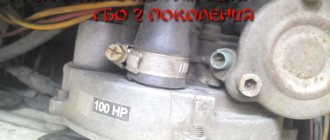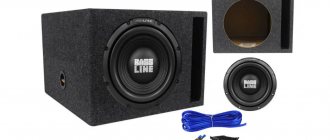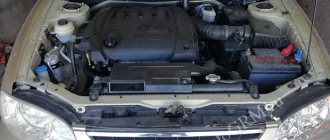The subwoofer is an important part of the car music system. Working at high power and low frequencies, it gives the sound a rich and rich sound. Conventional acoustic speakers have a number of limitations in the range of reproduced frequencies. They are not able to provide deep bass, without which musical fragments lose their strength and expressiveness. Speakers are divided into passive and active devices. A passive subwoofer consists of a loudspeaker specifically designed to reproduce low frequencies, a crossover filter, and an enclosure. Such a system requires a low frequency amplifier. The LF system can be connected to the terminals of a multi-channel amplifier or a separate amplifier can be provided for it. The active system for reproducing low frequencies has a special amplifier with a filter system. It is built into the housing where the woofer is located. In order for the car's sound system to work correctly, you will need to configure the subwoofer in the car.
How to set up a car subwoofer
The low-frequency component of the audio range is a narrow frequency band that starts from approximately 18-20 Hz and ends at 120-150 Hz. It is in this range that any subwoofer operates. Correctly setting up a subwoofer in a car is an important process on which the quality of low frequency reproduction will depend. If the sound system is not tuned, then the bass notes will “scatter” and lose pressure and richness. Instead of a rich and thick bass, a monotonous boom will be heard from the speaker, which, according to impressions, is in no way connected with the melody.
Setting up a subwoofer in a car depends on several factors:
- Speaker installation location
- Its power
- Operating frequency range
Typically, subwoofers in a car are installed in the luggage compartment or under the seat. If the column is installed under the seat, then too much power, if the system is not configured, can cause negative sensations for the driver and passengers.
Amplifier installation locations
- Under one of the front seats. Pros: close to the power source, radio; does not occupy functional space. Cons: overheats, inconvenient to install speaker wires.
- Under the back seat. Pros: does not take up useful space, does not overheat. Cons: as a rule, there is little space, and, consequently, low power of the device; far from the radio and power supply.
- Under the trunk lid. Pros: a lot of space for placement (you can install any device of any power), excellent ventilation, does not take up useful space, does not interfere. Cons: if the trunk shelf is very thin or flimsy, then the amplifier can create extraneous sounds, loosen the shelf, and the connectors in it can become loose; If the amplifier is designed to power not only a subwoofer, but also speakers, then it is very inconvenient to do the wiring.
- Place it on one side of the trunk. Pros: convenient installation, does not take up much functional space, convenient connection, you can install several amplifiers, good cooling of the device. Cons: far from all devices.
- On the trunk lid. They don’t take up space, good ventilation, easy connection, beautiful. Cons: possible loosening of the device and the trunk lid itself, possible short circuits of wires in places of kinks, far from all devices.
- On the back of the rear seats. Pros: plenty of space for installation, good cooling, convenient installation, ability to route wiring in detail on different sides of the machine, powerful mount, does not take up functional space. Cons: wires may break if the backrests are folded frequently, far from the sources.
- On the wall of the subwoofer. Pros: close to acoustics, does not take up extra space, installation and dismantling is simple, powerful cooling. Cons: strong vibration of the sound source can damage the amplifier.
How to properly set up an active subwoofer in a car
By reproducing low frequencies, the unit allows you to expand the dynamic range of any musical work. Speakers located in the doors or on the front panel are not designed to reproduce bass confidently. A properly configured subwoofer copes well with this task. The car bass amplifier panel contains several adjustments that allow you to fine-tune the low-frequency speaker system. Setting up an active subwoofer in a car on an amplifier includes the following adjustments:
- Gain (Level) – input sensitivity
- Sub Sonic – low pass filter
- Phase – phase adjustment
- LPF (Low pass filter) – low pass filter
- BassBoost – increase the volume in a narrow frequency band
To know how to properly configure an active sub, you need to understand what each adjustment is responsible for.
Starting point for acoustic tuning
At the entry level, anything beyond adjusting crossovers and gain levels doesn't matter. In addition, it does not matter how the amplification part is implemented. The basic principle is always the same.
Here's how to set up the amplifier:
- To begin with, turn off any sound adjustment circuits.
- If this is not possible, then the correction is set to zero. It is worth remembering that this is not the same thing - in the first option, the signal will not go through the correction circuits. This means that its path will be shorter and the level of distortion will be lower.
- In passive crossovers, the RF control is set to approximately the average level, even if it is different from zero. You should select a value of -3 dB.
- In the case of active crossovers, the crossover frequency of the low-pass and high-pass filters is initially made the same. The level should be around 75-80 Hertz.
The gain level on any channels is set to the very minimum position. If all these conditions are met, then optimal basic settings can be achieved.
Optimal settings for a subwoofer
How to set up a subwoofer in a car using an amplifier. Input sensitivity is not a volume control, although increasing it will also increase the volume. The “Gain” function matches the levels of the head unit and the active subwoofer amplifier. The handle is made to fit a slot for a screwdriver and can have digital designations, for example, from 0.2 to 5.0 V. There are several methods for matching levels. If you don’t have an oscilloscope at hand, then the correct setting of the subwoofer is done by ear. A good quality music signal with a low volume level is supplied to the subwoofer input. First, the “Gain” knob is set to minimum. Next, the volume on the head unit is slowly increased until audible distortion appears. The level is then reduced until a clear sound appears. The “Gain” is adjusted in the same way, increasing the signal level until distortion appears and “turning it back” a little.
When playing music fragments, the recording may contain very low overtones or infra-low frequencies. These sounds are practically not perceived by the human ear, but the electromagnetic system of the speaker senses them, and the diffuser reacts to them. At such low frequencies, the cone stroke increases and at high volume levels the voice coil may fail. To cut off such parasitic vibrations, an infra-low frequency filter or “SubSonic” is built into the subwoofer. This car subwoofer control cuts off all frequencies from 25-30 Hz and below. The filter is adjustable and next to the knob the cutoff frequency is indicated, which can be selected within the range of 10 Hz-50 Hz. This adjustment is not available on all active subwoofers.
Sound waves emitted by speakers located in different places reach the listener differently. In this case, the sound picture loses its integrity and is heard blurred, since the individual sound streams are shifted in phase relative to each other. Adjusting the “Phase” is needed to eliminate this defect and synchronize the subwoofer with the rest of the speaker systems. The easiest setting is to listen to music, with an assistant turning the adjustment until you get the best sound. To fine-tune the phase, you will need a sine wave generator. First you need to change the polarity of the speaker. Then feed the signal to the general amplifier and the subwoofer. Rotate the “Phase” control to achieve the quietest sound. This will mean that the speakers are out of phase. Then restore the correct polarity. The phase is adjusted correctly.
Correct setup of an active subwoofer is impossible without adjusting the LPF filter. Since the subwoofer speaker is designed only to reproduce low frequencies, this adjustable filter cuts all frequencies above a certain threshold, allowing only the low-frequency component to pass through. The adjustment indicates the limits for setting the cutoff frequency. This can be 40-250 Hz or other values. Typically, subwoofers set the filter cutoff frequency in the range of 50-65 Hz.
The “BassBoost” control allows you to increase the block gain in a narrow frequency band. Usually this is 40-45 Hz. This adjustment is used to equalize the amplitude-frequency response in a certain area. It is not recommended for those who are not specialists in automotive electronics to touch this adjustment. If you raise the gain too much, you can easily burn the subwoofer. Using measuring instruments, you can better tune the subwoofer in your car, but this can also be done by ear.
Bassboost
Bassboost - increases the volume at a certain frequency, usually 40-45 Hz.
When using a bass boost, the chance of burning the subwoofer increases sharply, since clipping occurs much earlier. In most cases, bassboost is not needed and if you are a beginner, then just accept the rule “Don’t touch bassboost!”
Experienced people can use it to increase the frequency response shelf in order to draw out dips in certain frequencies, but these are already deep settings and the effect does not always justify the risk.
How to set up a monoblock for a subwoofer in a car
A monoblock or single-channel amplifier is designed to connect only one speaker system, so such models are often used for subwoofers. The device has exactly the same adjustments as a multi-channel amplifier, so setting up the blocks is no different.
An important step is to jointly set up the subwoofer on the amplifier. The fact is that the front speaker amplifier also has filters, the settings of which may not match. If the filter on the subwoofer cuts off all frequencies above 60 Hz, and the filter on the front speaker amplifier cuts off all frequencies below 100 Hz, then a dip in the amplitude-frequency response will form between the two devices and frequencies in the range of 60-100 Hz will simply not be reproduced. This can be avoided by adjusting the cutoff frequencies of the two filters so that they slightly overlap each other. The quality of playback deteriorates both at the dip and at the hump of the frequency response. Setting up a subwoofer in a car is for dummies. Professionals use measuring equipment and more complex techniques.
How to adjust a subwoofer in a car
Most car enthusiasts do not have the necessary measuring equipment to properly configure the subwoofer. All settings are performed “by ear”, so to obtain a satisfactory result you need to follow some recommendations. Music for setting up a subwoofer in a car should be carefully selected. To adjust the low-frequency path, you should not use electronic music played on a synthesizer. To auditorily assess the sound quality at low frequencies, you need to play fragments of classical music with wind and string instruments.
Electronic sound is rich in artificial overtones, which do not allow you to objectively evaluate the sound, especially at low frequencies. There is no need to rush when making adjustments, as some settings will have to be repeated several times to get the desired result. In general, high-quality setup can take several hours. There is no need to use unfamiliar musical passages when tuning. It is better if the classic work is well known. To objectively evaluate the complex sound of car acoustics, you need to be in the driver’s seat inside the car. All interior windows and doors must be closed. You need to check the sound on several works where different musical instruments are used. How to set up a subwoofer in a car video.
How to properly set up a passive subwoofer in a car
Setting up a passive subwoofer in a car begins with the manufacture of the box for the woofer. You can purchase a passive radiator, but many car enthusiasts prefer to make this design with their own hands. The passive system is available in two versions: a closed box and a box with a bass reflex. In turn, bass reflexes are divided into slot and pipe-shaped. Compared to a closed box, bass reflex systems have greater efficiency. In addition, the slot bass reflex, after assembling the box, is not subject to any adjustment. The phase shifter, made in the form of a pipe, can be adjusted by lengthening or shortening the structure. The passive bass reflex does not have electrical settings, so the settings of the head unit and amplifier are used to obtain the necessary parameters.
How to properly adjust a subwoofer in a car. When making a homemade subwoofer, a lot depends on the diameter of the acoustic head. A speaker with a 12" cone will be more active at low frequencies than a speaker with a 10" cone.
Preparing equipment for adjustment
First, you need to pay attention to the process of installing equipment in a car. A suitable location is selected depending on whether the subwoofer is used - active or passive.
How to adjust an active subbuffer
The active version of the acoustics consists of two housings. One contains the amplifier, the other contains the main device. Installing such equipment is relatively simple. The main component is most often placed under the driver's seat, since this place is located close to the battery - you don't have to bother with wires. However, this will somewhat muffle the sound of the bass, and not everyone likes the vibration that occurs at some points.
An active subwoofer is easy to install, but requires careful configuration
You can also place the component in the back seat or on a special shelf. This will make it possible to better distribute sound throughout the cabin, but you will need to use several wires. Take two wires: narrow and wide. Connect them to the terminals of the acoustic equipment. The wide wire must be attached to the “+” terminal on the battery, and the narrow wire to the radio.
Most models of active equipment are equipped with a relatively weak bass amplifier. You can achieve normal sound only when listening at low volume. Its increase leads to the appearance of wheezing and other distortions. To avoid this, pay special attention to the settings.
How to set up passive acoustics
Passive subwoofers do not have a built-in amplifier, but it can be connected separately. Just make sure that the power of the main component is less than the power of the amplifier, otherwise it will overheat!
A passive subwoofer is popular with most audiophile drivers
How to set up a subwoofer in a car radio
Setting up a radio and subwoofer in a car includes a number of sequential operations. First, using the HPF high-pass filter on the head unit, you need to cut off the low frequencies that are fed to the front speakers. If a subwoofer is installed in the car, then the cutoff frequency can be selected within the range of 80-120 Hz and the attenuation slope is 24 dB per octave. The subwoofer on the radio is adjusted using the LPF low-pass filter. To do this, select the “Subwoofer Control” item in the menu. There are three parameters to set here:
- Filter cutoff frequency
- Volume level
- Attenuation slope
These values are set by ear when playing your favorite musical styles. The settings for different radios may differ, but in general they are the same.
Turning off Demo mode
Immediately after purchasing and connecting the radio, you should figure out how to disable the demo mode, intended for displaying the device in the store. It is possible to use the radio in this mode, but it is inconvenient, since when you turn it off, the backlight does not go out, and inscriptions with various information run across the display.
Disabling demo mode is very simple:
- We go to the hidden menu by turning off the radio and holding down the SRC button.
- In the menu, turn the wheel to reach the DEMO item.
- Switch demo mode from ON to OFF.
- Exit the menu using the BAND button.
You can also set the date and time in the hidden menu by going to the System section. The time display is switched here (12/24 hour mode). Then open the “Clock Settings” item and turn the wheel to set the time. In the System section there is also a language setting (English/Russian).
Thus, after purchasing a modern Pioneer model, you can easily set up the radio yourself. By correctly adjusting the audio parameters, you can achieve very high-quality sound even from a simple audio system and get a good sound picture at minimal cost.
How to adjust a subwoofer
In order to adjust the subwoofer in the car, you can use special CDs designed for tuning car speaker systems. A disc is placed in the car radio on which a sequence of tracks is recorded. They record reference signals from the audio frequency generator with high quality. Using such recordings, you can correctly set the cutoff frequencies of the high- and low-pass filters, adjust the balance and phase.
In car services, they can correctly configure the low-frequency unit using special computer programs to configure the subwoofer in the car.
Selecting wires to connect the amplifier
Now let's look at how to connect an amplifier in a car. Nowadays there are entire kits for connecting acoustics on sale. However, the quality of the wires in the kits is rather questionable. The best option is to purchase special speaker wires.
For the rear and front speakers, a PVA cable with a cross-section of 2x2.5 mm is suitable, for high-frequency (tweeters) a wire with a cross-section of 2x1.5 mm is suitable, for a subwoofer 2x4 mm.
The amplifier is powered from the battery using wires of type KG-25 or 35.











